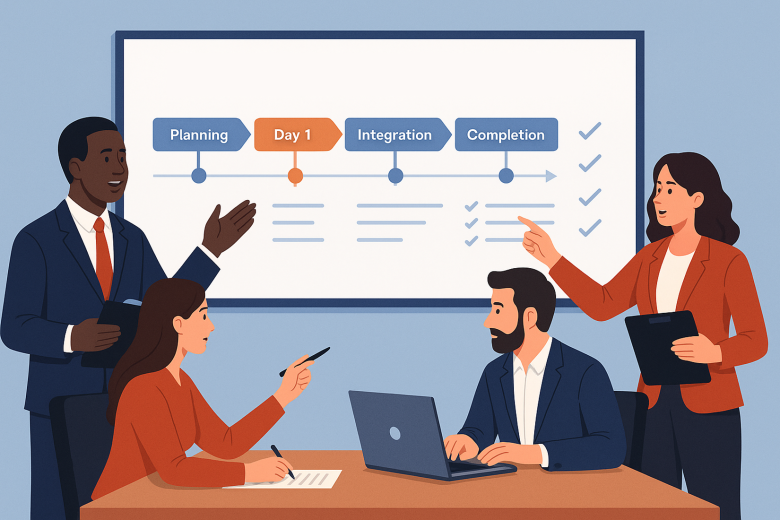Inside the Mind of the IT Services Founder: What Drives M&A Decisions on the Buy Side?
When you ask the founder of a small IT services company why they decided to acquire another firm, you’re unlikely to hear them talk about EBITDA multiples or valuation models. Instead, you might hear something much more personal:
“We just couldn’t build that capability quickly enough.”
“We liked the team—they shared our mindset.”
“We identified an opportunity in the UK market and didn’t want to wait two years.”
This is the true narrative behind mergers and acquisitions in the small IT services sector. It’s not about spreadsheets; it’s driven by ambition, identifying gaps, and following gut instinct.
1. Building Capabilities They Can’t Build Alone
Most small IT services firms begin with a specific niche, such as cloud migration, DevOps support, or SAP rollouts. However, markets are constantly evolving. AI is changing client expectations, cybersecurity has become essential, and clients increasingly seek a single partner who can manage all their needs.
For founders, acquiring another firm is not merely about growth; it’s about filling a crucial gap in their capabilities. For example, when Mumbai-based Xebia acquired Appcino, a low-code specialist, it was not just a financial decision. This acquisition provided Xebia with expertise in a rapidly growing area that its enterprise clients were demanding. Similarly, a founder in Pune might consider purchasing a 40-person cybersecurity consultancy in London, as it’s often faster and more efficient to acquire expertise than to develop it internally from the ground up.
2. Reaching New Clients and New Markets
Many Indian IT services companies aim to enter the markets in the US or UK, but achieving organic growth can be slow, costly, and challenging. Acquiring a firm with an established local client base and sales team can dramatically change this situation overnight.
I remember a founder from Delhi sharing his experience after acquiring a boutique firm in Texas: “We weren’t just buying revenue; we were buying relationships. They already had CIOs at Fortune 500 companies responding to their calls.”
This strategy is also applicable within India. For instance, a firm based in Hyderabad might acquire a Bengaluru-based company to gain access to clients in the banking, financial services, and insurance (BFSI) sectors. Similarly, a boutique firm in London might purchase a development team in Manchester to secure government contracts. Ultimately, geography plays a significant role, and acquisitions can provide a fast track to market entry.
3. Culture First, Always
Here’s something that spreadsheets can’t capture: culture.
When the Australian firm Nuago (with just 60 employees) agreed to be acquired by Brennan IT, it wasn’t the highest bidder that won them over—it was the one that understood their company culture. Nuago’s founders wanted their team to feel valued and for their way of working to continue after the merger.
Similarly, small IT founders on the buying side think along the same lines. No founder wants to acquire a team that resents the deal or leaves immediately after the agreement is finalised. They seek companies that share their values, work ethic, and a similar approach to serving clients. In the IT services sector, your real “assets” go home every night.
4. Growth at the Right Pace
Every founder faces a choice: grow gradually or take a leap. Organic growth is safer, but it can be slow—often too slow for a rapidly changing market. On the other hand, an acquisition can significantly accelerate growth by introducing new service lines, clients, and geographical markets.
However, what many don’t openly acknowledge is that founders are not pursuing “growth at any cost.” They have witnessed the consequences of overpaying or hastily pursuing an ill-suited acquisition. A prime example is Atos’ acquisition of Syntel, where the company paid more than three times the market value and struggled with integration, ultimately leading to financial difficulties. Founders pay close attention to these cautionary tales; they desire acceleration without the accompanying complications.
5. Legacy and the Human Side of the Deal
Whether buying or selling, most IT founders think about their legacy.
On the buy side, they want to preserve what the seller has built—they aim to enhance it. On the sell side, founders are not merely looking for a check; they want to ensure their team is well taken care of.
This is why many deals include arrangements like earn-outs or partial exits. Founders appreciate flexibility: some may choose to stay on for three years to help transition clients, while others may step away immediately but still provide strategic guidance.
Ultimately, what matters most to founders is the story behind the acquisition: Will it strengthen their company, make their team proud, and better serve their clients?
So, What Does This Mean for Sellers?
If you’re a founder considering the sale of your IT services company, it’s important to understand that buyers are looking beyond just the numbers. They want to know:
- Will your skills, clients, or intellectual property fill a gap for them?
- Do your employees align with their company culture?
- Will this acquisition enable them to access opportunities they couldn’t achieve on their own?
Providing strong answers to these questions is often more significant than presenting a flawless profit and loss statement.
The Bottom Line
Small IT services acquisitions aren’t typically made in boardrooms; they happen through conversations between founders, late-night WhatsApp chats, and quiet gut-checks about whether “this feels right.”
To truly understand how mergers and acquisitions (M&A) work in the IT services sector, you need to grasp what motivates a founder to acquire capabilities they cannot develop on their own, reach new markets, or preserve specific cultures.
At this level, M&A is not solely about financial gain. It encompasses momentum, meaning, and the legacy a founder wishes to establish.










